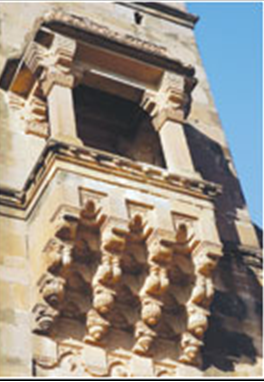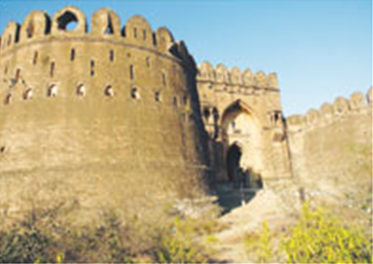Rohtas Fort
This is a collection of articles archived for the excellence of their content. Readers will be able to edit existing articles and post new articles directly |
Rohtas Fort
The majestic Rohtas Fort
By Arsalaan Haleem
Approximately 109 kilometres from Rawalpindi and 16 kilometres north-west of the city of Jhelum, lies one of the finest specimens of military fortifications ever constructed in our part of the world — the majestic Rohtas Fort.
Rohtas Fort, or Qila Rohtas (as locals like to call it), was commissioned by Sher Khan, better known as Sher Shah Suri, between 1540 – 1550 AD. Constructed on a low lying rocky hill, next to a gorge, which in its time also doubled as a wide moat to ward off possible invaders, is a classic example of the predominantly Pathan architectural style of the mediaeval times.
Named after an original site, where Suri once defeated Mughal forces, the fort is a symbol of strength and determination of its builder, Sher Khan, who constructed the fort to block Emperor Humayun’s return to India, as well as to defend against the possible onslaught of the Gakhars — the local warrior tribes, who were loyal to Humayun. The construction of the fort was supervised by one of his trusted generals; but was completed during the tenure of Jalal Khan, Sher Shah’s son and immediate successor.
The fort lies on an ancient route that runs southward to the fertile land of Indus Valley and eastward to the plains of Ganges, from the mountainous region of the north. The famous Grand Trunk Road, also constructed during Sher Shah’s tenure, passes along this route, connecting Kabul to Calcutta as well as various ancient and current cities along the way.
The area surrounding the fort is also famous for being the landing area for the famous Greek general Alexander’s troops during his conquest of the sub-continent.
Spread over an area of four kilometres, the fort’s sandstone parameter is a three-tiered structure, interconnected into three separate terraces, with the outer wall reaching a maximum height of 18.30 metres high, whereas at other places it is only 10 metres high. The widest portion is near the Mori gate with 12.4 metres.
Atop the outer walls, the embankments are strengthened by hundreds of merlon-shaped battlements with loop-holes for pouring down molten lead or oil onto the invaders. At various places, the inner walls have been hollowed out into galleries that may have been used either as sleeping quarters or storage vaults.
The most impressive features of Rohtas Fort are its 68 semi-circular bastions and the 13 grand stone arched gateways. These gates, though of different sizes and at irregular intervals, give the fort the awe-inspiring nature that it posses. These are: Langer khana, Shishi, Kabuli, Gaddaiwala, Sohail, Sar, Pipalwala, Tulla Mori, Gatiali, Khawas Khani, Kashmiri, and the Shan Chandwali Gate, the last mentioned is the only gate that opens into the inner courtyard, the rest are part of the outer parameter.
Though all the gates provide an entry route, the main entrance is through the Khawas Khani gate on the eastern side. The main path, then forks out into two: one leads to the ancient settlement of Rohtas and the other to Anderkot — living-quarters inside the fort — and to the southern Sohail Gate.
The thriving village of Rohtas has been in existence from the times of Jamal Khan and comprises several neighbourhoods, divided by a main road, which due to its antiquity have been declared a Heritage Street.
Of the original buildings of the inner courtyard, only two — Shahi Mosque and Haveli Man Singh, named after one of Emperor Akbar’s generals, survive today. Three deep step-wells, most probably constructed during the time of Sher Khan, are also in good shape.
Though the fort has withstood the elements for almost five centuries, its strong structure has started to crumble. The ravages of human occupancy have defaced and even destroyed certain areas of the massive structure. Sadly, people visiting this tourist site do not respect its cultural value and its history and leave traces of their visits by defacing the walls and littering around.
Lack of knowledge and importance of this monument have brought about a mindset of apathy from the locals living in and around the fort, which has also played a part in the fort’s destruction. Lack of proper planning and government’s empathetic interest has let to a large squalid dwellings develop around the fort that causes further damage to the historical monument.
Being one of the handful forts of Middle Ages in the world today, Rohtas Fort is listed in the Unesco’s World Heritage List of 1997 and is also protected by the Antiquities Act of 1975 by the Federal Government of Pakistan.
Supported by Pakistani and Norwegian Governments, and co-sponsored by an oil marketing company, an international conservations organisation, The Himalayan Wildlife Foundation (HWF) is engaged in the restoration and conservation of the monument since 2001 and is running many projects under the Rohtas Fort Conservation Programme. It hopes to restore it to its former glory soon.
Rohtas Fort2
An architectural marvel
Text and photographs by Tanveerul Islam
Located near Jhelum off the Grand Trunk (GT) Road, Rohtas Fort was built by Sher Shah Suri, the Afghan ruler known for his adminstrative skills during his five-year rule in the subcontinent. The fort is one of the most imposing historical monuments in Punjab and is situated on the edge of the Kahan gorge, which provided the only route from the mountainous area north of the Salt Range to the southern plains.
Sher Shah constructed Rohtas Fort to block Emperor Humayun’s return to India after defeating him in the Battle of Kanauj. To intercept his return to India Suri garrisoned his troops along the route between Lahore and Peshawar.
The other reason for the fort was to suppress the local tribes called Gakhars who were allies of Humayun and refused their allegiance to him. The Gakhars made a feeble retort by building some fortifications near the village of Sultanpur, which still remain today. Begun in 1541, it took almost eight years to built this magnificent garrison fort.
The fort derives its name after the Rohtasgarh fort in Bihar which Sher Shah had captured from the Raja of Rohtas, Hari Krishan Rai in 1539. Owing to its awe-inspiring features of strength and massiveness, and being the finest example of mediaeval military architecture in Pakistan, Unesco included the fort in the World Heritage List, in 1997.
The fort is a unique piece of cultural heritage for the people. Built in sandstone the height of the wall varies between 10 and 18 meters whereas its thickness is between 10 to 13 meters. Interestingly the fort has never been under seige in the past.
About four kilometers in circumference the fort houses shrines, a mosque, an execution tower and three baowlees (water reserviors made by cutting deep into the rock). There are no buildings inside the fort except the Haveli Maan Singh named after Akbar's famous general.
Most of the fort is in good state of preservation but at places the walls are falling off. The vast tracts inside the fort have been turned into a jungle. To bring the fort in its original state requires not only huge funds and expertise but a commitment on the part of both the government and the NGO sector.











